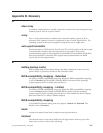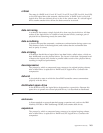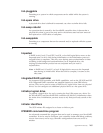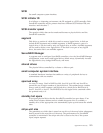
F
fault tolerance
The ability of a computer system to operate correctly even though one or more of
its component parts are malfunctioning.
firmware
Proprietary code that is usually delivered as microcode as part of an operating
system. Firmware is more efficient than software loaded from an alterable medium
and more adaptable to change than pure hardware circuitry. An example of
firmware is the Basic Input/Output System (BIOS) in read-only memory (ROM) on
a PC motherboard.
FlashCopy
A point-in-time capture of logical drive data on a networked storage device. As
new data are written to the original logical drive, the FlashCopy view captures the
changes. If an error occurs in the original logical drive, you can roll-back the
logical drive to the point when the FlashCopy was created.
FlashCopy virtual size
For a FlashCopy backup of logical drive data, the virtual size is the maximum size
that the FlashCopy can grow to. The virtual size equals the size of the FlashCopy
source drive. The actual size of a FlashCopy backup starts at 10% of the FlashCopy
source. As new data are written to the source drive, the FlashCopy backup grows
to the size of FlashCopy source.
foreign array
An array with exported data, allowing the drives and RAID configuration to be
transferred to another enclosure.
free space
The space in an array currently not assigned to a logical drive.
G
GB
When referring to hard-disk-drive capacity, GB means 1 000 000 000 bytes, or 1000
MB. Total user-accessible capacity may vary depending on operating environment.
H
high availability
A system designed and implemented with components that satisfy the system
functional requirements, but also has hardware and software component
redundancy to eliminate any unexpected behavior.
hot add
To add and configure a new ServeRAID controller while the server is operational.
264 ServeRAID Manager Installation and User's Guide


















